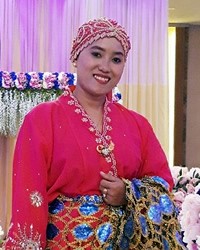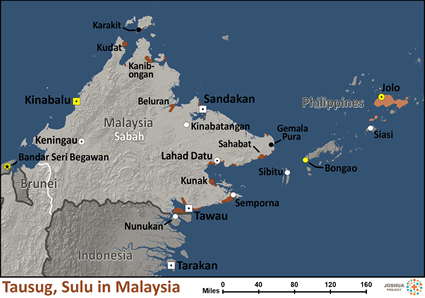A number of different people groups, known collectively as South Philippine Muslims, live on the Sulu Archipelago, an island chain between the Philippines and the island of Borneo. The Tausug are by far the most dominant of all these groups. The Sulu are a sub-group of the Tausug. The term Tausug means "people of the sea current." They probably came to the islands from northeastern Mindanao as a result of Chinese trade in the thirteenth and fourteenth centuries.
The Tausug are also known as Suluks or Sulu in Sabah. In the past, the Tausug made their living as pirates but now rely on farming, fishing, and livestock production. The majority of Tausug reside on Jolo Island, and another significant group lives in Sabah, West Malaysia. A smaller number are in Indonesia.
The livelihood of the Sulu Tausug is based primarily on fishing and small-scale agriculture. In addition, they also raise some animals such as cattle, chickens, and ducks. The major cash crops are hemp, coconuts, coffee, and fruit. While some farmers still use a slash and burn method of cultivation, most raise rice in non-irrigated fields.
Fishing, whether part or full time, is done from motorized boats in offshore coastal waters. They use nets, hooks and lines, and various types of bamboo traps to fish. Most of the Sulu Tausug live in small coastal communities. The smallest territorial unit is the household, and the next largest unit is the village settlement, which often includes related family members. Still larger is the kauman (community), which has a common name and headman. The unity of the kauman depends on such factors as the amount of intermarriage among its members, the effective authority of the headman, and the attendance at a common mosque.
This situation reinforces the community's adherence to the Islamic religious system. The typical Sulu Tausug dwelling is raised six to eight feet above the ground. It generally consists of a rectangular room made of timber and bamboo, with a thatched gable roof. The house is surrounded by a series of elevated porches that lead to a separate kitchen. Usually, a fence is built around it for protection.
The ideal marriage among the Sulu Tausug is still one arranged by the parents. However, among younger people, courting may occur, and the young people are becoming freer to select their own mates. Parents prefer that they marry first and second cousins, but the younger generation is in the process of broadening their choices.
Children sometimes study the Koran with a private tutor, and they have a public ceremony when they are ready to recite the scriptures. Sons are circumcised in their early teens, and it has been reported that daughters are also "circumcised" at six or seven years of age. Girls help their mothers with household duties, while boys help their fathers in the fields or with fishing.
The exact time Islam was introduced to the Sulu Tausugs is not known. However, it may have occurred as early as the tenth century when Arab trade was active with southern China via the islands.
Sunni Islam is the majority religion of the Sulu Tausug. Despite the influence of Islam, they retain some of their animistic beliefs and practices associated with the spiritual world. Their view of life after death mixes Islamic beliefs with non-orthodox beliefs in spirits. They believe that a person has four souls which leave his body when he dies. The body of the deceased goes to hell, where the punishment of his sins will be revealed according to his wrongdoings while he was living.
Lack of workers and lack of prayer are two of the largest obstacles to the advance of the gospel among the Sulu Tausugs and other Muslims from this region.
Pray for good quality Christian radio to be available in the Tausug language, in Malaysia, the Philippines, and Indonesia.
Pray the people will learn of these broadcasts and will listen with understanding and faith to believe.
Pray that the few Sulu Tausug Christians will fellowship together and will grow in the nurture and admonition of the Lord.
Pray they will be faithful witnesses for Christ to family and friends.
Scripture Prayers for the Tausug, Sulu in Malaysia.
| Profile Source: Joshua Project |


























